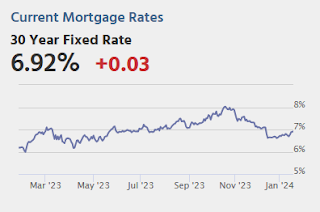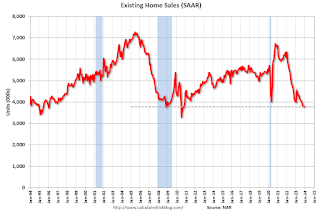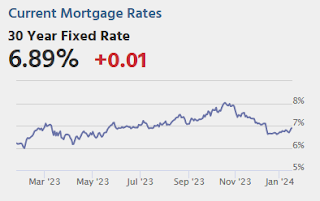by Calculated Risk on 1/19/2024 07:45:00 PM
Friday, January 19, 2024
Jan 19th COVID Update: Weekly Deaths Increased

| COVID Metrics | ||||
|---|---|---|---|---|
| Now | Week Ago | Goal | ||
| Hospitalized2 | 27,882 | 29,807 | ≤3,0001 | |
| Deaths per Week2🚩 | 1,768 | 1,712 | ≤3501 | |
| 1my goals to stop weekly posts, 2Weekly for Currently Hospitalized, and Deaths 🚩 Increasing number weekly for Hospitalized and Deaths ✅ Goal met. | ||||
 Click on graph for larger image.
Click on graph for larger image.This graph shows the weekly (columns) number of deaths reported.
Q4 GDP Tracking: Around 1.8%
by Calculated Risk on 1/19/2024 02:01:00 PM
The advance estimate of Q4 GDP will be released next week, and the consensus is for real GDP (SAAR) of 1.8%.
From BofA:
Overall, since our last weekly publication, our 4Q US GDP tracking estimate is up two-tenths to 1.3% q/q saar, while 3Q GDP finalized at 4.9% q/q saar in the third estimate. [Jan 12th estimate]From Goldman:
emphasis added
Following today’s data, we left our Q4 GDP tracking unchanged at +1.8% (qoq ar) and our Q4 domestic final sales growth forecast also unchanged at +2.5% (qoq ar). [Jan 19th estimate]And from the Altanta Fed: GDPNow
The GDPNow model estimate for real GDP growth (seasonally adjusted annual rate) in the fourth quarter of 2023 is 2.4 percent on January 19, unchanged from January 18 after rounding. After this morning's existing-home sales report from the National Association of Realtors, the nowcast of fourth-quarter real residential investment growth decreased from -0.4 percent to -0.6 percent. [Jan 19th estimate]
NAR: Existing-Home Sales Decreased to 3.78 million SAAR in December; Months-of-Supply above December 2019
by Calculated Risk on 1/19/2024 10:50:00 AM
Today, in the CalculatedRisk Real Estate Newsletter: NAR: Existing-Home Sales Decreased to 3.78 million SAAR in December; Months-of-Supply above December 2019
Excerpt:
Sales Year-over-Year and Not Seasonally Adjusted (NSA)There is much more in the article.
The fourth graph shows existing home sales by month for 2022 and 2023.
Sales declined 6.2% year-over-year compared to December 2022. This was the twenty-eighth consecutive month with sales down year-over-year. This was just below the previous cycle low of 3.79 million SAAR in October.
On an annual basis, sales were down 19% from 2022 to the lowest level since 1995.
NAR: Existing-Home Sales Decreased to 3.78 million SAAR in December; Lowest Annual Sales Since 1995
by Calculated Risk on 1/19/2024 10:00:00 AM
From the NAR: Existing-Home Sales Slid 1.0% in December
Existing-home sales retreated in December, according to the National Association of REALTORS®. Among the four major U.S. regions, sales slipped in the Midwest and South, rose in the West and were unchanged in the Northeast. All four regions experienced year-over-year sales decreases.
On an annual basis, existing-home sales (4.09 million) dropped to the lowest level since 1995, while the median price reached a record high of $389,800 in 2023.
Total existing-home sales – completed transactions that include single-family homes, townhomes, condominiums and co-ops – decreased 1.0% from November to a seasonally adjusted annual rate of 3.78 million in December. Year-over-year, sales declined 6.2% (down from 4.03 million in December 2022).
...
Total housing inventory registered at the end of December was 1 million units, down 11.5% from November but up 4.2% from one year ago (960,000). Unsold inventory sits at a 3.2-month supply at the current sales pace, down from 3.5 months in November but up from 2.9 months in December 2022.
emphasis added
 Click on graph for larger image.
Click on graph for larger image.This graph shows existing home sales, on a Seasonally Adjusted Annual Rate (SAAR) basis since 1994.
Sales in December (3.78 million SAAR) were down 1.0% from the previous month and were 6.2% below the December 2022 sales rate.
 According to the NAR, inventory decreased to 1.00 million in December from 1.13 million the previous month.
According to the NAR, inventory decreased to 1.00 million in December from 1.13 million the previous month.The last graph shows the year-over-year (YoY) change in reported existing home inventory and months-of-supply. Since inventory is not seasonally adjusted, it really helps to look at the YoY change. Note: Months-of-supply is based on the seasonally adjusted sales and not seasonally adjusted inventory.
 Inventory was up 4.2% year-over-year (blue) in December compared to December 2022.
Inventory was up 4.2% year-over-year (blue) in December compared to December 2022. Months of supply (red) decreased to 3.2 months in December from 3.5 months the previous month.
This was below the consensus forecast. I'll have more later.
Thursday, January 18, 2024
Friday: Existing Home Sales
by Calculated Risk on 1/18/2024 07:40:00 PM

Friday:
• At 10:00 AM ET, Existing Home Sales for December from the National Association of Realtors (NAR). The consensus is for 3.84 million SAAR, up from 3.82 million.
• Also at 10:00 AM, University of Michigan's Consumer sentiment index (Preliminary for January).
4th Look at Local Housing Markets in December; California Home Sales Down 7.1% YoY in December
by Calculated Risk on 1/18/2024 04:04:00 PM
Today, in the Calculated Risk Real Estate Newsletter: 4th Look at Local Housing Markets in December
A brief excerpt:
Here is some more local data prior to the NAR release tomorrow.There is much more in the article.
Note: The National Association of Realtors (NAR) is scheduled to release December existing home sales on Friday, January 19th, at 10:00 AM ET. The consensus is the NAR will report sales of 3.84 million SAAR, up from 3.82 million in November.
Housing economist Tom Lawler expects the NAR to report sales of 3.84 million SAAR for December.
...
And a table of December sales.
In December, sales in these markets were down 7.5%. In November, these same markets were down 6.3% YoY Not Seasonally Adjusted (NSA).
Sales in almost all of these markets are down sharply compared to December 2019.
...
Annual sales for 2023 will be at the lowest level since 1995.
Several local markets - like Illinois, Miami, New Jersey and New York - will report after the NAR release.
LA Port Inbound Traffic Increased Year-over-year in December
by Calculated Risk on 1/18/2024 03:15:00 PM
Notes: The expansion to the Panama Canal was completed in 2016 (As I noted several years ago), and some of the traffic that used the ports of Los Angeles and Long Beach is probably going through the canal. This might be impacting TEUs on the West Coast (recently the drought in Panama has slowed canal traffic).
Container traffic gives us an idea about the volume of goods being exported and imported - and usually some hints about the trade report since LA area ports handle about 40% of the nation's container port traffic.
The following graphs are for inbound and outbound traffic at the ports of Los Angeles and Long Beach in TEUs (TEUs: 20-foot equivalent units or 20-foot-long cargo container).
To remove the strong seasonal component for inbound traffic, the first graph shows the rolling 12-month average.

On a rolling 12-month basis, inbound traffic increased 1.3% in December compared to the rolling 12 months ending in November. Outbound traffic increased 0.5% compared to the rolling 12 months ending the previous month.
 Usually imports peak in the July to October period as retailers import goods for the Christmas holiday, and then decline sharply and bottom in February or March depending on the timing of the Chinese New Year.
Usually imports peak in the July to October period as retailers import goods for the Christmas holiday, and then decline sharply and bottom in February or March depending on the timing of the Chinese New Year. Realtor.com Reports Active Inventory UP 7.9% YoY; New Listings up 7.0% YoY
by Calculated Risk on 1/18/2024 12:40:00 PM
Realtor.com has monthly and weekly data on the existing home market. Here is their weekly report: Weekly Housing Trends View — Data Week Ending January 13, 2024
• Active inventory increased, with for-sale homes 7.9% above year ago levels.
Active listings in the past week grew by 7.9% above the previous year, the 10th straight week of annual growth. Active inventory picked up slightly compared to the previous week, diverging from the typical seasonal pattern which would suggest falling inventory until the spring market picks up in March. Should the uptick in new listings persist, inventory levels could continue to improve as hesitant buyers and sellers make their move ahead of the flurry of activity in the spring.
• New listings–a measure of sellers putting homes up for sale–were up this week, by 7.0% from one year ago.
After an extended period of less listing activity from sellers due to the mortgage rate lock-in effect, newly listed homes have risen above last year’s levels for the 12th week in a row. This past week, the number of newly listed homes was 7.0% higher than the same time last year. However, the pace of new listings is still expected to be below typical pre-pandemic levels. In this past week, the new listing count was still 21.3% below similar weeks in 2017 to 2020.
 Here is a graph of the year-over-year change in inventory according to realtor.com.
Here is a graph of the year-over-year change in inventory according to realtor.com. Inventory was up year-over-year for the 10th consecutive week following 20 consecutive weeks with a YoY decrease in inventory.
Single Family Starts Up Year-over-year in December; Near Record Number of Multi-Family Housing Units Under Construction
by Calculated Risk on 1/18/2024 09:15:00 AM
Today, in the Calculated Risk Real Estate Newsletter: Single Family Starts Up Year-over-year in December; Near Record Number of Multi-Family Housing Units Under Construction
A brief excerpt:
The third graph shows the month-to-month comparison for total starts between 2022 (blue) and 2023 (red).There is much more in the article.
Total starts were up 7.6% in December compared to December 2022. And starts in 2023 were down 9.0% compared to 2022.
Starts were down year-over-year for 16 of the last 20 months, although starts were up year-over-year in 4 of the last 8 months. The year-over-year comparisons will be easier in 2024.
Weekly Initial Unemployment Claims Decrease to 187,000
by Calculated Risk on 1/18/2024 08:42:00 AM
The DOL reported:
In the week ending January 13, the advance figure for seasonally adjusted initial claims was 187,000, a decrease of 16,000 from the previous week's revised level. This is the lowest level for initial claims since September 24, 2022 when it was 182,000. The previous week's level was revised up by 1,000 from 202,000 to 203,000. The 4-week moving average was 203,250, a decrease of 4,750 from the previous week's revised average. The previous week's average was revised up by 250 from 207,750 to 208,000.The following graph shows the 4-week moving average of weekly claims since 1971.
emphasis added
 Click on graph for larger image.
Click on graph for larger image.The dashed line on the graph is the current 4-week average. The four-week average of weekly unemployment claims decreased to 203,250.
The previous week was revised up.
Weekly claims were below the consensus forecast.


